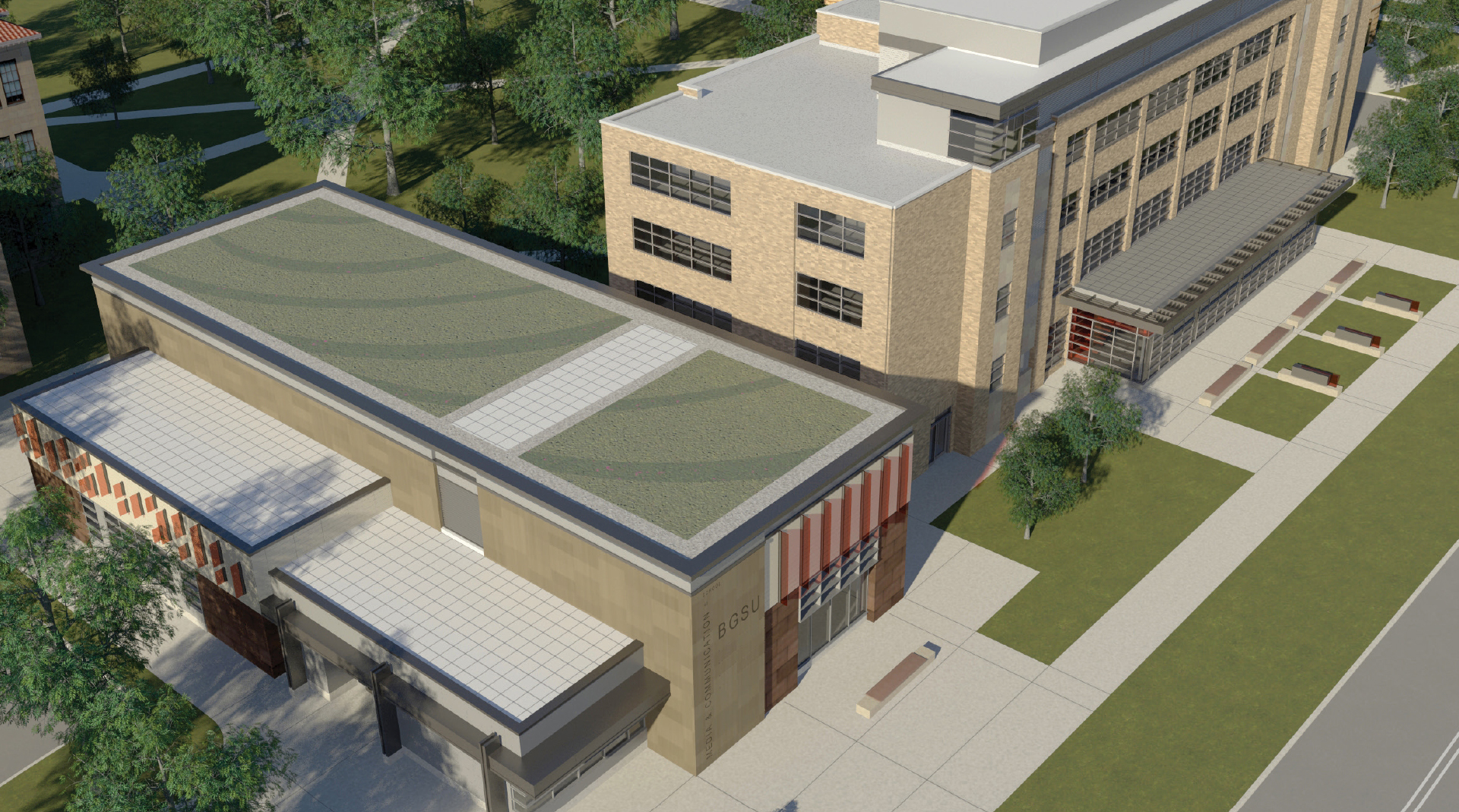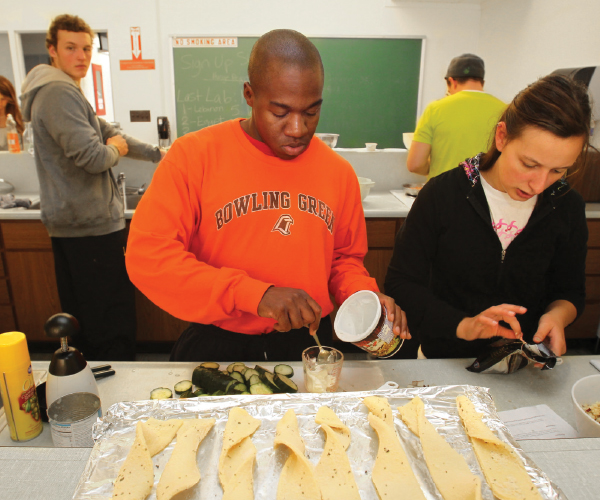

Renovation Transforms Space for School of Media & Communication
An exciting renovation of South Hall is currently under way. Upon completion in fall 2016, the $24 million transformation and expansion will make South Hall the new home of the BGSU School of Media & Communication.
But for some BGSU media and communication graduates, the new home is actually the building they remember as home to their programs and student media offices. Mizell Stewart III, who graduated in 1994 with a degree in magazine journalism, recalls when the offices for the student radio stations, TV station and BG News were on the fourth floor of South Hall.
“We had reel-to-reel tape, cart machines like an 8-track, audio boards and a huge record library shared by the two radio stations,” he said. When the journalism and then-radio-TV-film programs consolidated and moved into West Hall, the technology was updated from LPs to CDs. The move into South Hall next fall will move the programs from CDs to completely digital, Stewart pointed out.
The disciplines of media studies and production, journalism and communication programming, and curricula adaptive to the 21st century come together under the umbrella of the School of
Media & Communication.
“Our purpose in the School of Media & Communication is to prepare students for careers in a rapidly changing industry in which media are converged and practices are collaborative,” said Raymond A. Craig, dean of the College of Arts & Sciences. “The investment to create collaborative and technology-enhanced spaces in South Hall provides students with a foundation for future careers and lives we cannot imagine now. School of Media & Communication students in all programs will benefit directly by working in exciting collaborative activities and spaces—this is the hallmark of a quality BGSU education.”

The new South Hall design focuses on content development, editing and delivery using digital tools and a high-speed intranet. The building features signature spaces, including a multiplatform convergence lab, audio/video/production suites, conference facilities, media effects lab, recording and broadcast studios and collaboration spaces — all equipped with state-of-the-art, professional-grade equipment and technology. The new facility will be home to BGSU’s student-run media outlets, including the nationally recognized newspaper BGNews, WFAL radio and On-Air BG24 News, all of which provide students with real-world, hands-on training and technical experience.
Like many of the programs’ graduates, “the student media were an important part of my BGSU experience,” said Stewart, who currently leads news content strategy on digital and print platforms for Journal Media Group, a group of 14 newsrooms across the U.S. “I found that for every leadership role I have had, student media had a part in my success. I carry those lessons with me today.”
Stewart is pleased with the plans for the “new” South Hall. The concept of news labs across platforms is exciting, he said.
“To be able to produce and edit audio, video, narrative and still photography all in one learning lab is exactly what the students need.”
Because technology changes frequently, and the industry is changing so rapidly, “traditional boundaries are being erased,” Stewart explained.
He called the digital platform “the great equalizer,” making it possible to choose the best medium for story. Maybe it’s a podcast. Maybe it’s video. Or maybe still photography and a written story conveys the story best, he added.
This type of training will prepare students to be better journalists and better decision makers in multi-media. “Part of my interest in this is to make sure students have the best opportunities and that employers have access to top talent,” Stewart said. “As a graduate and a new member of the BGSU Alumni Association Board of Directors, my passion is working with BGSU’s School of Media & Communication to make sure there is a pipeline of young people who know how to tell stories that matter.”
“And these are skills that transfer to many jobs beyond journalism. Our graduates will be able to tell stories in businesses, nonprofits and other disciplines because everyone is a storyteller these days with Facebook, video, pictures and social media.”
The new space and the technology planned for the building will help students have familiarity with as many media as possible, Stewart added. “We really do not know what local media will look like in two years, let alone 10 years. The building is a big step in making sure BGSU graduates have the tools, experience and flexibility to meet the changing needs.”

Revolutionizing Research
More campus construction brings new labs across campus to encourage collaboration, multidisciplinary breakthroughs
Renovations to several academic buildings at the University’s Bowling Green and Firelands campuses are expanding the depth and breadth of leading-edge research opportunities for faculty and students.
Moseley Hall, BGSU’s original science and agriculture building, is being restored to its original role, without the agricultural component, to create the Interdisciplinary Science Complex. The work is scheduled to be finished in fall 2017.
The complex will feature state-of-the-art, flexible laboratory spaces not constrained by walls, allowing for teamwork and research activity between the STEM disciplines, including science, technology, and mathematics. The $23 million project will provide interdisciplinary active-learning classrooms along with teaching labs for medical technology, biology, anatomy and physiology, and chemistry. Flexibility is a key concept in its planning, to allow for maximal use.
The 29,000-square-foot science complex will shift from a conventional-content model to an outcome-based model where students and faculty are focused on problem-based, collaborative, team-oriented research.
“The design principles include open, natural light and collaboration spaces and labs with dramatic glass walls for spontaneous brainstorming and idea sharing where virtually all visitors, students and faculty can observe cutting-edge scientific discoveries taking place right in front of them,” said Dr. Raymond Craig, dean of the College of Arts and Sciences. “The multidisciplinary breakthroughs made possible will revolutionize research at BGSU.”
The College of Health and Human Services is also getting updated labs, research and classroom facilities as part of a $9.2 million overall expansion and renovation. The improvements will be finished in fall 2016.
A new sensory tasting lab, a food science lab and a teaching kitchen are providing improved research spaces for the Food and Nutrition program, which was integrated into the college on July 1, 2015.
The Food and Nutrition Teaching Kitchen supports the fully accredited undergraduate degree in dietetics. Lab experiences are an integral part of the dietetics major, and the HHS renovation project supports a 14-unit food preparation laboratory where students learn about food production and delivery systems with emphasis on equipment, principles of safe food handling, quality standards and controls, menu planning and environmental issues. The building also houses a new Food Sciences Lab for physical and chemical analysis of foods and a Sensory Evaluation (Tasting) Laboratory to support the research of faculty, students and other collaborators. It will also foster teaching sensory evaluation laboratory skills and helping students develop a greater understanding of the science of aroma, taste, color and texture of food.
The Biomedical Research Laboratory will provide state-of-the-art facilities to support faculty and student research in cellular, biochemical and molecular aspects of basic and applied biomedical sciences. Students in various programs will have opportunities to participate in faculty-mentored research. The Public and Allied Health Research Laboratory will provide a platform for the integration of programs such as public health, medical laboratory science and food and nutrition.
The new labs for the Department of Human Services will bring together faculty and students who have a mutual desire to study and investigate social issues facing our complex communities, and to provide training to students who will be prepared to assist individual and groups in need. Examples of current research include: crime prevention, issues facing students who are in the military, community-oriented policing initiatives, the impact of race and class on crime and the criminal justice system, police corruption, intergenerational relationships, provision of care for individuals with dementia, grief and bereavement, and intimacy in later adulthood.
“These new labs will allow for an integration of programs and promote faculty and student collaborations,” said
Dr. Marie Huff, dean of the College of Health and Human Services. “Not only that, they will also help showcase our research to prospective students and support joint grant applications, publications
and presentations.”
A 12,700-square-foot, two-story addition to the current North Building at BGSU Firelands is providing critically needed laboratory spaces in the natural and physical sciences, allowing the expansion of upper-division course offerings that support STEM disciplines. It will serve as a catalyst for new bachelor’s degree programs. The new space will welcome students for the spring 2016 semester.
“The Allied Health and Sciences Project fulfills immediate campus and student needs and accommodates the near-term growth of the college. It also represents a commitment on behalf of BGSU to satisfy the growing need for the education of health care professionals in the community,” said Dr. Andrew Kurtz, dean of the college.
The LEED-certified facilities accommodate high-demand degree programs in nursing and allied health careers including radiologic technology, respiratory care, diagnostic medical sonography, and health information technology, as well as supporting critical courses in the basic sciences.
“BGSU Firelands has positioned itself to be a leader in preparing health care professionals while the community demand for these careers grows,” Kurtz added. “The Allied Health and Sciences Project will allow BGSU Firelands and the community to be the premier leader in the delivery of health care education in our region while enhancing other degree offerings in business, technology and public service.”
Private support will provide the measure of difference for new spaces and new places throughout Bowling Green State University. Contact University Advancement at 888-839-2586 for information about funding opportunities.
Updated: 12/01/2017 11:58PM
